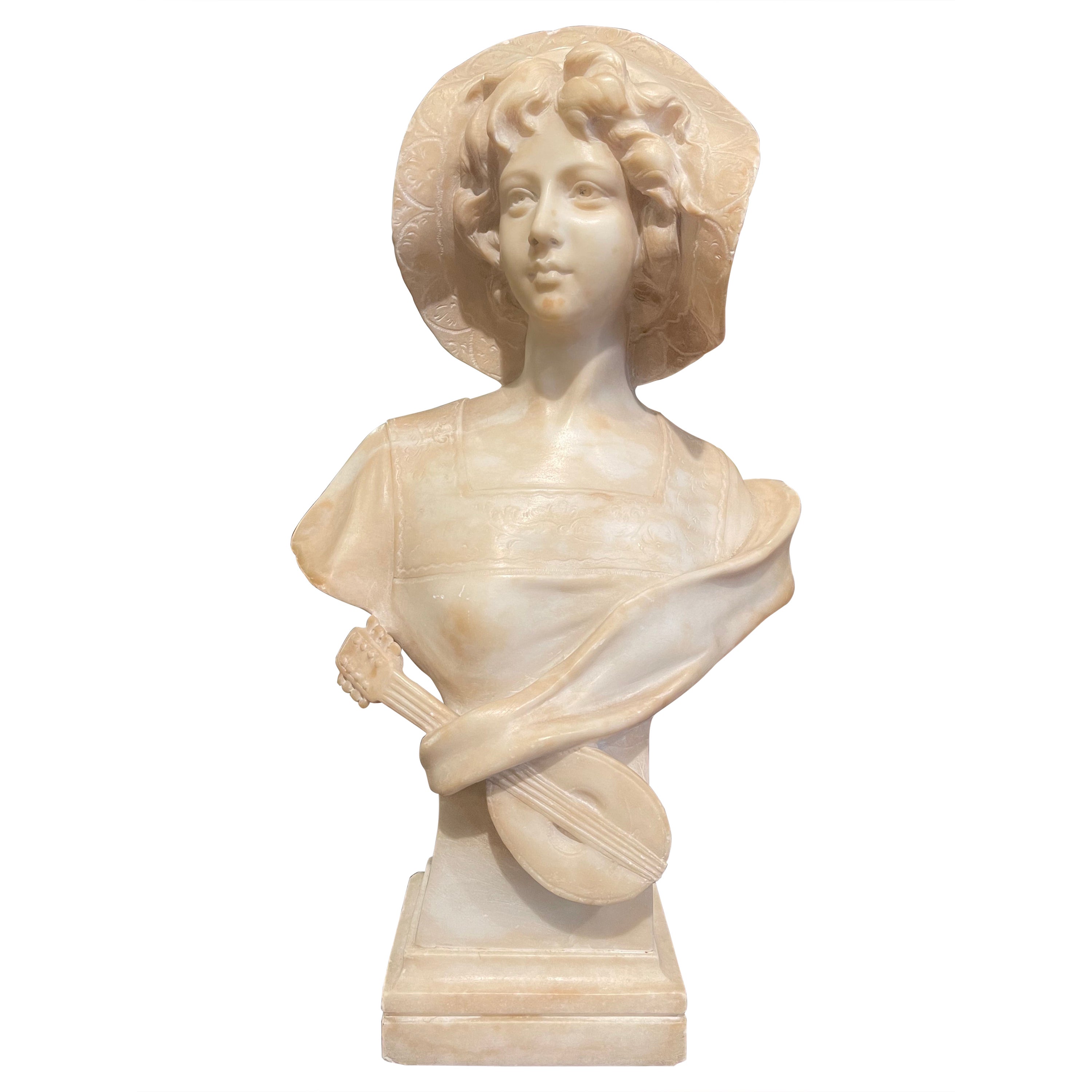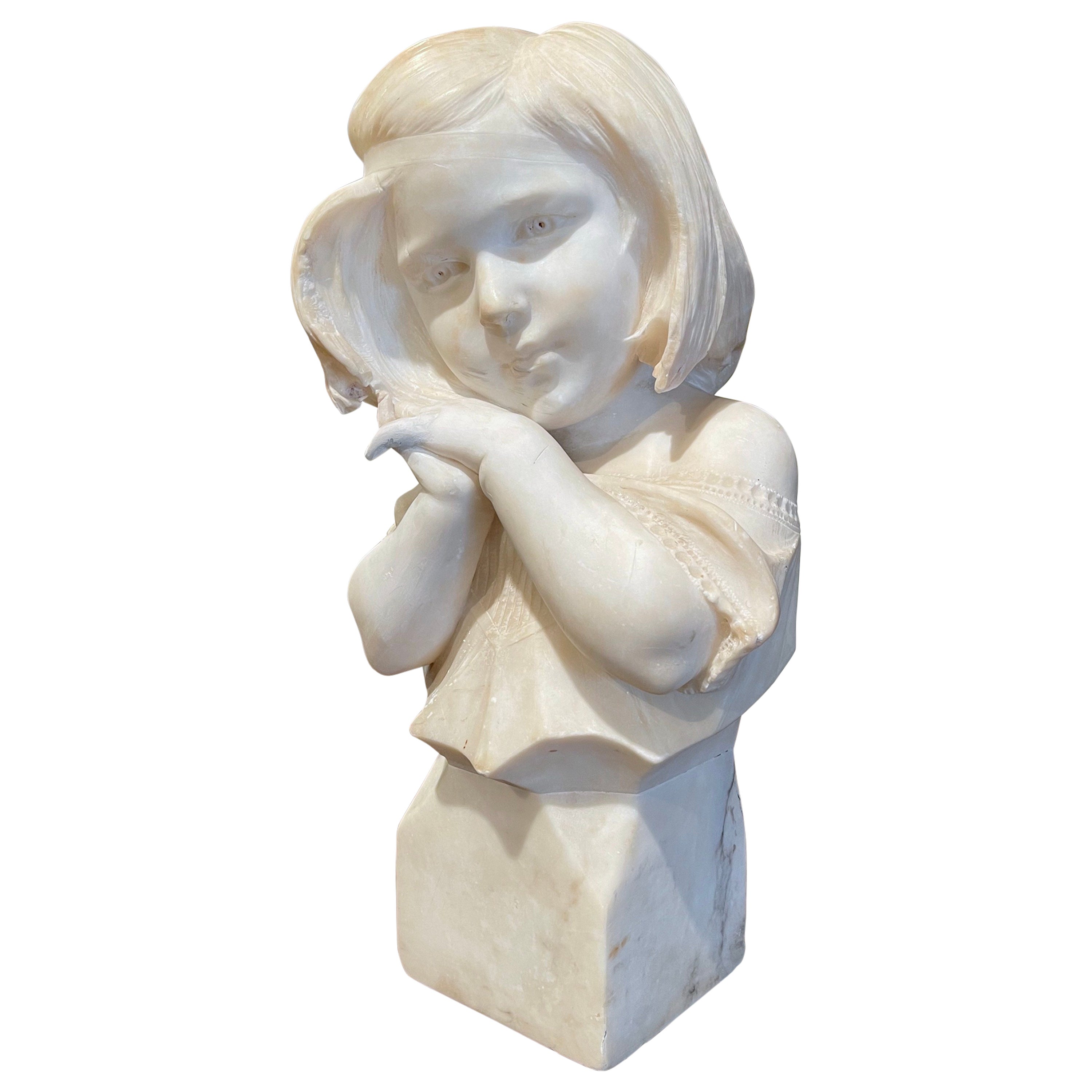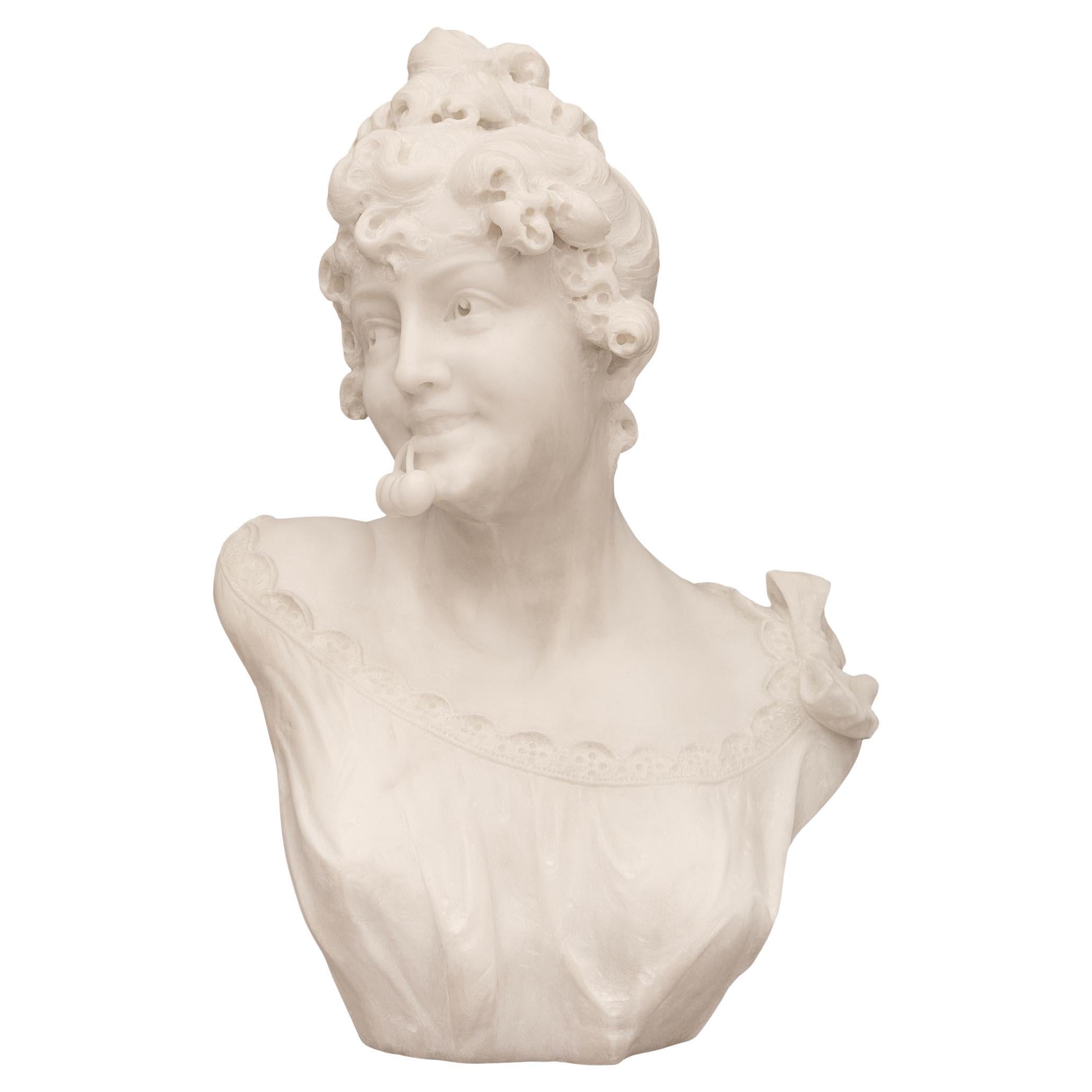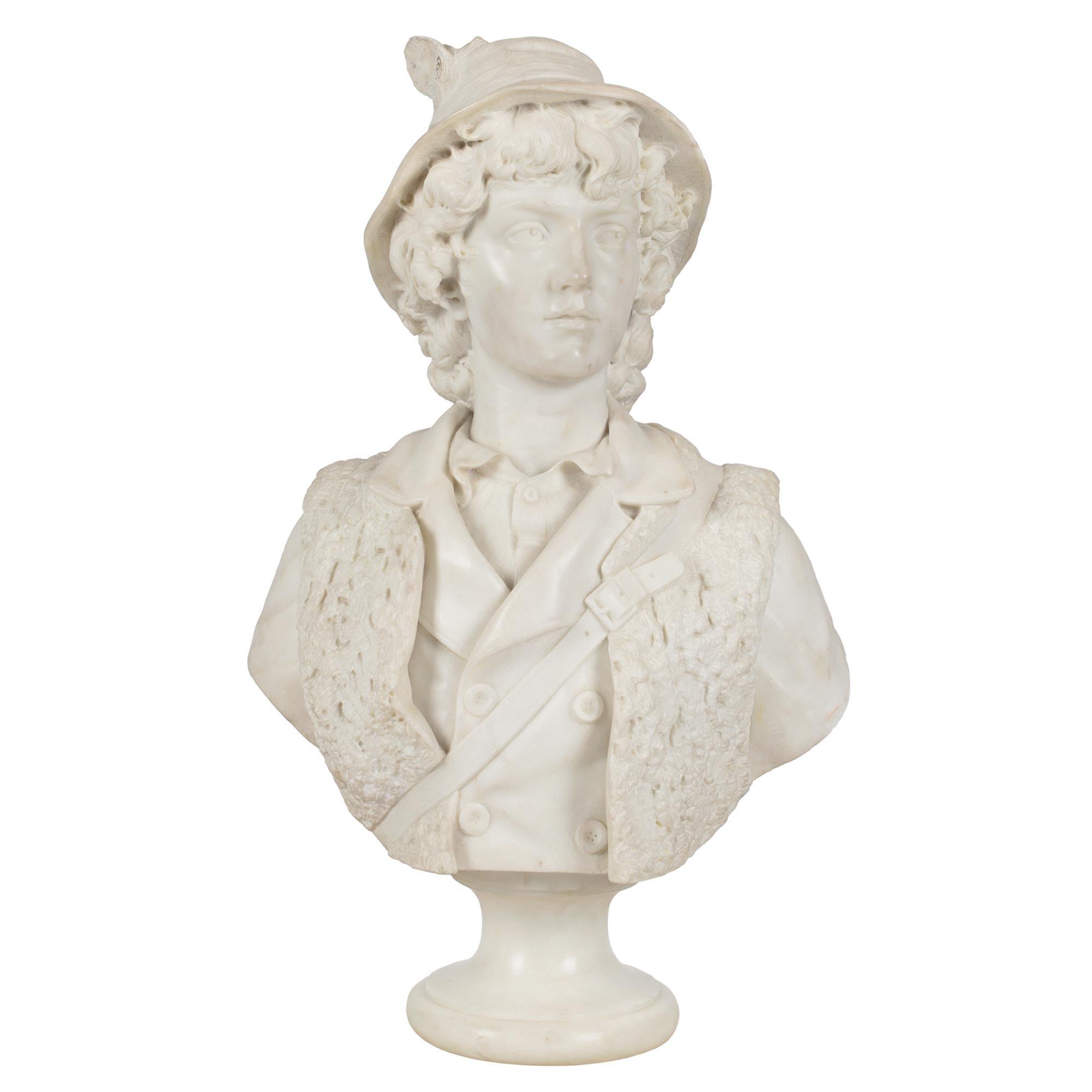Items Similar to Very Fine French 19th Century White Marble Bust of a Young Beauty by René Rozet
Want more images or videos?
Request additional images or videos from the seller
1 of 21
Very Fine French 19th Century White Marble Bust of a Young Beauty by René Rozet
About the Item
A very fine and large French 19th century white marble bust of a young beauty, purported to be a young "Marie Antoinette" (Queen of France 1755-1793), by René Rozet (French, 1859-1939). The beautifully delicately carved and sensual life-size marble bust of the young beauty posing with a profile gaze and curly pulled-back hair, crowned with a floral garland, her wrapped dress-top with lace and fringes tied with a central button, on a waisted Brocatelle-pink marble socle and raised on a mottled-yellow sienna marble cylindrical pedestal stand with a square white marble plinth. Signed: R. Rozet. Circa: Paris, 1870-1880.
The Paris-born sculptor René Rozet (1859-1939) trained with classmate Louis Majorelle at the Academie de Beaux-Arts under renowned sculptor Aimé Millet. He exhibited regularly at the Paris Salon as well as the Salon des Artistes Français, where he was awarded Hors Concours and a gold medal in 1927. He was awarded the Légion d'Honneur in 1912.
Literature: BENEZIT, E., Dictionnaire critique et documentaire des peintres, sculpteurs, dessinateurs et graveurs, tome 12, Paris, 1999, S. 63.
Marie Antoinette (/m?'ri? æntw?'n?t/ or /æntw??'n?t/; French: [ma?i ?~twan?t]; baptised Maria Antonia Josepha Johanna (2 November 1755-16 October 1793), born an Archduchess of Austria, was Dauphine of France from 1770 to 1774 and Queen of France and Navarre from 1774 to 1792. She was the fifteenth and penultimate child of Maria Theresa of Austria and Francis I, Holy Roman Emperor.
In April 1770, upon her marriage to Louis-Auguste, Dauphin of France, she became Dauphine of France. She assumed the title Queen of France and of Navarre when her husband ascended the throne as Louis XVI upon the death of his grandfather Louis XV on 10 May 1774. After seven years of marriage, she gave birth to a daughter, Marie-Thérèse Charlotte, the first of her four children.
The French people eventually came to dislike her, accusing "L'Autrichienne" (which literally means the Austrian (woman), but also suggests the French word "chienne", meaning bitch) of being profligate, promiscuous, and of harbouring sympathies for France's enemies, particularly Austria, her country of origin. The Diamond Necklace incident damaged her reputation further. She later became known as Madame Déficit because France's financial crisis was blamed on her lavish spending and her opposition to the social and financial reforms of Turgot and Necker.
After the revolutionaries placed the royal family under house arrest in Paris, an attempt to flee (the flight to Varennes) had disastrous effects on French popular opinion: Louis XVI was deposed and the monarchy abolished on 21 September 1792; the royal family was subsequently imprisoned at the Temple Prison. Nine months after her husband's execution, Marie Antoinette was herself tried, convicted by the Revolutionary Tribunal of treason to the principles of the revolution, and executed by guillotine on 16 October 1793.
Long after her death, Marie Antoinette remains a major historical figure linked with conservative and the Catholic Church positions; and a major cultural icon associated with high glamour, wealth and a certain style of life based on luxury and celebrity appealing today to the social and cultural elites; frequently referenced in popular culture, being the subject of several books, films and other forms of media. Most academics and scholars, have deemed her the quintessential representative of class conflict, western aristocracy and absolutism government in addition to being frivolous, superficial; and have attributed the start of the French Revolution to her in addition to the beginning of the French Revolutionary Wars of 1792 which ended with the Congress of Vienna with their millions of victims and the introduction of nationalistic and modern ideas. On the other hand, Marie Antoinette supported the American Revolution in 1776 and the American Revolutionary War, and helped inspire a conservative reaction in France after 1791, which saw its greatest manifestation in the War in the Vendée which led, several years after the death of the queen, to the end of the Revolution and to the return of conservative and religious ideas in France and in Europe. That tendency saw its first manifestation in the writing of Edmund Burke, the most important theorist of modern conservative thought, who criticized the Revolution as early as 1790 and defended Marie Antoinette in his various books. For some, Marie Antoinette was a victim of her family ambition and the general situation in France, in addition, even some of her critics recognize her qualities as a mother, her courage in dying, even her charisma. She also patronized the arts, sciences and fashion.
Early Life
Maria Antoinette was born on November 2, 1755, in Vienna. She was the youngest daughter of Empress Maria Theresa and Emperor Francis I. Marie Antoinette was not a lonely child. This was evident in her relationship with her sister, Maria Carolina.
Antonia's schooling was rather poor. At the age of ten, she still had trouble writing correctly. Conversations with her were stilted.
Antonia learned to play the harp, and the harpsichord. During the family's gatherings in the evenings, she would sing, as she had a beautiful voice. She also excelled at dancing, had an "exquisite" poise, and loved dolls. Her relationship with her family was rather complex, especially with her mother, who loved her, but raised her strictly with the firm intention of her youngest daughter becoming a queen. Marie Antoinette said one day when she was queen of France: "I love the Empress but I'm frightened of her, even at a distance; when I'm writing to her, I never feel completely at ease"
Marriage to Louis: 1770–1793
Maria Antonia was married by proxy on 19 April in Vienna to the Dauphin.
Marie Antoinette was officially handed over to comtesse de Noailles, her lady in waiting, until 1775, in charge of the proper court behavior (étiquette) Marie-Antoinette was to follow.She met the king and the Dauphin. Before reaching Versailles, she also met her brothers-in-law, Louis Stanislas Xavier, comte de Provence; and Charles Philippe, comte d'Artois. Later, she met her husband's youngest sister, Madame Élisabeth.
Profile medallion of Marie Antoinette as Dauphine of France in 1770, allegorical to her marriage.
The ceremonial wedding took place on 16 May 1770, in the Palace of Versailles, after which was the ritual bedding. The lack of consummation of the marriage plagued the reputation of both Louis-Auguste and Marie Antoinette for seven years to come.
The initial reaction to the marriage between Marie Antoinette and Louis-Auguste was mixed. On the one hand, the Dauphine herself was popular among the people. Her first official appearance in Paris, on 8 June 1773 at the Tuileries, was considered by many witnesses a resounding success. People were easily charmed by her personality and beauty. She had fair skin, straw-blond hair, blue eyes and with her high heels and majestic tall figure, she was a head taller than her court acquaintances, including her family. On the other hand, those opposed to the alliance with Austria, and others, such as the comtesse du Barry, had tenuous relationships with the Dauphine.
Her relationship with the comtesse du Barry was one which it was important for her to improve, at least on the surface, because Madame du Barry was the mistress of Louis XV, and thus had considerable political influence over the king. In fact, du Barry had been instrumental in ousting the duc de Choiseul, who had helped orchestrate the Franco-Austrian alliance as well as Marie Antoinette's own marriage. After months of continued pressure from her mother and the Austrian minister, the comte de Mercy-Argenteau, Marie Antoinette grudgingly agreed to speak to Mme du Barry on New Year's Day 1772 in order to stop any French protest about the partition of Poland. Although the limit of their conversation was Marie Antoinette's banal comment to the royal mistress that, "there are a lot of people at Versailles today", Mme du Barry was satisfied by her victory with the result that she controlled Marie Antoinette's daily life until 1774 making her a virtual prisoner at court under her control and the crisis, for the most part, dissipated. Later, Marie Antoinette became more polite to the comtesse because she needed her approval before doing anything important, pleasing Louis XV, but also particularly her mother.
From the beginning, the Dauphine had to contend with constant letters from her mother, who was receiving secret reports on her daughter's behavior from Mercy d'Argenteau.
Marie Antoinette also began to form deep friendships with various ladies in her retinue. Most noted were the princesse de Lamballe, whom she appointed as Superintendent of her Household. Others taken into her confidence at this time included Christoph Willibald Gluck, her former music teacher, whom she took under her patronage.
On 10 May 1774, Louis XV died. On May 12, the new king Louis XVI under the queen influence, by lettre de cachet, exiled Mme du Barry. On 14 May, Marie-Antoinette wrote to her mother: " The public expected lots of changes at the moment;: the king simply sent the creature to the convent and chased away from the court all that bear this name of scandal. (In a letter to Mercy dated 18 May, Marie-Thérèse mentions Marie-Antoinette's letter to her: "she wrote to me about it with vehemence, treating her of creature...")
On 11 June 1775, Louis was crowned king Louis XVI of France at the cathedral of Reims. Following the custom, Marie Antoinette was not crowned alongside him. Had she been crowned Queen of France, the ceremony would have taken place at the Basilica of Saint Denis.
Queenship: 1774–1792
1774–1778: Early years
At the outset, the new queen had limited political influence with her husband. Louis blocked many of her candidates, including Choiseul,[43] from taking important positions, aided and abetted by his two most important ministers, Chief Minister Maurepas and Foreign Minister Vergennes. In spite of that, the queen played a decisive role in the disgrace and exile of the most powerful of Louis XV ministers, the Duke of Aiguillon.
The queen plunged further into the costly diversions of buying her dresses from Rose Bertin and gambling on a massive scale. For formal occasions, she adopted a hair style, the pouf which made her look more than a foot taller in addition to her high heels giving her a majestic and dominating presence over the heads of her court making her the center of the social life in Versailles, it was created shortly before by her hairdresser, Léonard Autié. She also began to attract various male admirers including the baron de Besenval, the duc de Coigny, and Count Valentin Esterházy.
She was given free rein to renovate the Petit Trianon, a gift to her by Louis XVI on 15 August 1774; The Petit Trianon became associated with Marie Antoinette's perceived extravagance. With the "English garden", Marie Antoinette and her court adopted the English dress of indienne, of percale or muslin. The tradition of costume at the court at Versailles was broken after more than ten years. Rumors circulated that she plastered the walls with gold and diamonds. Her lady-in-waiting Jeanne-Louise-Henriette Campan defended her reputation and simplicity.
Repayment of the French debt remained a difficult problem, further exacerbated by Vergennes' and specially Marie Antoinette's prodding Louis XVI to involve France in Great Britain's war with its North American colonies; the queen played a very important role in supporting the American Revolution by, first, securing Austrian and Russian support for France which resulted in the establishment of a neutral league which stopped England's attack on international trade; second, the queen sent a lot of her retinue to fight in America; third, Marie Antoinette supported both Franklin and Jefferson in their social lives in Paris and Versailles in their work as Ministers to Frarnce, and finally, the queen nominated the ministers of war and the navy in 1780 who were able successfully to help George Washington in defeating the British in the American Revolutionary War and ending the war in 1783. Amidst the atmosphere of the first wave of libelles, the Holy Roman Emperor Joseph came to call on his sister and brother-in-law on 18 April 1777. During the subsequent six-week visit to Versailles, Joseph investigated why the royal marriage had not been consummated. He soon came to the conclusion that no obstacle to the couple's conjugal relations existed, save the queen's lack of interest and the king's unwillingness to exert himself in that arena. In a letter to his brother Leopold, Joseph graphically described them as "a couple of complete blunderers." Due to Joseph's intervention, the marriage was finally consummated in August 1777. Eight months later, in April, it was suspected that the queen was finally pregnant with her first child, which was confirmed on 16 May 1778.
Measures: Overall height: 81 1/2 inches (207 cm)
Bust height: 33 1/8 inches (84 cm)
Bust width: 28 3/8 inches (72 cm)
Bust depth: 12 5/8 inches (32 cm)
Pedestal height: 48 3/8 inches (123 cm)
Pedestal width: 14 5/8 inches (37 cm)
Pedestal depth: 14 5/8 inches (38 cm).
- Creator:René Rozet 1 (Sculptor)
- Dimensions:Height: 81.5 in (207.01 cm)Width: 23.38 in (59.39 cm)Depth: 14.63 in (37.17 cm)
- Style:Rococo (In the Style Of)
- Materials and Techniques:
- Place of Origin:
- Period:
- Date of Manufacture:circa 1870-1880
- Condition:Wear consistent with age and use. Minor losses. A truly stunning bust. Overall condition is very good. Some age rubbing, pin holes and age surface scratches, minor carving losses to flowers. Some soft sanding on back. Pedestal white bottom base has nicks, losses and wear. Please view all images.
- Seller Location:Los Angeles, CA
- Reference Number:
About the Seller
5.0
Vetted Seller
These experienced sellers undergo a comprehensive evaluation by our team of in-house experts.
Established in 1982
1stDibs seller since 2016
Typical response time: <1 hour
- ShippingRetrieving quote...Ships From: Los Angeles, CA
- Return PolicyThis item cannot be returned.
More From This SellerView All
- Fine Italian 19th-20th Century Carved Two-Color Alabaster Bust of a Young BeautyLocated in Los Angeles, CAAn Italian 19th-20th century carved color-alabaster bust of a young beauty. The finely carved two-tone alabaster bust, depicting a young girl posing with a side gaze and wavy hair ti...Category
Antique Early 1900s Italian Country Busts
MaterialsAlabaster
- French 19th Century Carved Marble Sculpture of a Young Boy Prince on a PillowBy Jean-Baptiste PigalleLocated in Los Angeles, CAA very fine and charming French 19th century carved white marble sculpture of a young prince seated on a pillow with tassels. In the manner of Jean-Baptiste Pigalle (French, 1714-178...Category
Antique 19th Century French Rococo Figurative Sculptures
MaterialsMarble
- Monumental Pair of French 19th-20th Century Putto Flambeaux Urns TorcheresBy René Rozet 1Located in Los Angeles, CAMonumental pair of French 19th century figural gilt and patinated bronze Rosso Granite marble Flambeaux Urns Torcheres, each depicting a pair of allegorical Putti (Children) holding ...Category
Antique 1890s French Louis XV Figurative Sculptures
MaterialsGranite, Bronze
- Fine Italian 19th-20th Century Lifesize Carved Marble Bust of a Posing LadyBy Antonio FrilliLocated in Los Angeles, CAA fine Italian 19th-20th century lifesize carved marble bust of a lady wearing a hat, the beautifully carved marble bust of a lady posing with a gaze to her right, wearing a bonnet w...Category
Antique Early 1900s Italian Romantic Busts
MaterialsMarble
- French 19th Century Bronze and White Marble Bust of Marianne in Full ArmorLocated in Los Angeles, CAA French 19th century bronze and marble bust of Marianne in full armor. The nicely cast Baroque Revival brown patinated bronze and carved white marble figure of Marianne, the allegorical personification of the French Republic, presented in her militaristic guise, reminiscent of Minerva, wearing a Phrygian helmet and armored breastplate centered by winged male mask and with lion shoulder armor pads, all raised on a conforming black marble base. Circa: 1890-1900. Marianne has been the national personification of the French Republic since the French Revolution, as a personification of liberty, equality, fraternity and reason, as well as a portrayal of the Goddess of Liberty. Marianne is displayed in many places in France and holds a place of honor in town halls and law courts. She is depicted in the Triumph of the Republic, a bronze sculpture overlooking the Place de la Nation in Paris, as well as represented with another Parisian statue on the Place de la République. Her profile stands out on the official government logo of the country, appears on French euro coins and on French postage stamps. She was also featured on the former franc currency and is officially used on most government documents. Marianne is a significant republican symbol; her French monarchist equivalent is often Joan of Arc. As a national icon Marianne represents opposition to monarchy and the championship of freedom and democracy against all forms of oppression. Other national symbols of Republican France include the tricolor flag, the national motto Liberté, Égalité, Fraternité, the national anthem "La Marseillaise", the coat of arms, and the official Great Seal of France. Marianne also wore a Cockade and a red Phrygian cap symbolizing Liberty. Minerva and its pendant bust of Mars evoke the classicizing subjects, bust-length formats, and style that originated in France during the reign of Louis XIV (1643–1715) and that concurrently was popularized across Europe. The busts' simple forms, stiff poses, and solemn facial types are consistent with the late Baroque sculptures that were carved in Flanders during this period. In Flanders, especially in Antwerp and Brussels, sculpture and architectural decoration traditionally was carved using combinations of native black marble (noir belge), mottled red marble (rouge belge), and white marble or alabaster. The use of these stones in colorful counterpoint speaks most strongly to the busts’ Flemish origins. The veneration of ideal heroes and heroines in ancient costume and arms took on extravagant form in the 17th century, with countless variations. Within this imaginative tradition, the identification of the pair as Minerva and Mars cannot be certain. The female bust, for example, could be identified as Bellona, Roman goddess of war, who is depicted in 17th and 18th century French paintings wearing flamboyantly plumed helmets and low-cut cuirasses that expose her breasts. Whatever their identities, the female and male warriors are portrayed as calm rather than bellicose beings. The sovereign pair does...Category
Antique 19th Century French Baroque Revival Figurative Sculptures
MaterialsMarble, Bronze
- Fine 19th Century White Marble Sculpture of “Rebecca at the Well”Located in Los Angeles, CAA Fine 19th century white marble sculpture of “Rebecca at The Well” depicting a Classical maiden wearing a robe, with one breast semi-exposed, stan...Category
Antique Late 19th Century Unknown Neoclassical Figurative Sculptures
MaterialsMarble
You May Also Like
- Rozet René, "Musician" Carrara Marble Sculpture, Period 19th CBy René Rozet 1Located in SAINT-OUEN-SUR-SEINE, FRThis statuary marble sculpture was made in the last decades of the 19th century by the French sculptor René Rozet. He is mastering in sculpted bust portrait...Category
Antique Late 19th Century French Romantic Figurative Sculptures
MaterialsMarble, Carrara Marble
- 19th Century French Carved White Marble Bust of Young Beauty with LuteLocated in Dallas, TXCrafted in France circa 1890, this antique marble sculpture stands on a square base, and depicts a young girl with a guitar draped in front of...Category
Antique Late 19th Century French Busts
MaterialsMarble
- 19th Century French Carved Two-Tone White Marble Bust of Young BeautyLocated in Dallas, TXCrafted in France circa 1890, this antique marble bust is a true representation of French elegance. The figural sculpture stands on an attached white and grey square base, and features a beautiful, young girl in a lace dress with delicately posed hands resting on her chin. There are a number of intricate, realistic details throughout her face, hair and clothing. The large, personalized female bust is excellent condition, and adorns a rich patinated finish. Place this elegant bust on a pedestal...Category
Antique Late 19th Century French Busts
MaterialsMarble
- Italian 19th Century White Carrara Marble Bust of a Young MaidenLocated in West Palm Beach, FLA lovely and high quality Italian 19th century white Carrara marble bust of a young maiden, signed R. Batelli. The wonderfully charming statue depicts a young maiden wearing a finely...Category
Antique 19th Century Italian Figurative Sculptures
MaterialsCarrara Marble
- Italian 19th Century White Carrara Marble Bust of a Young HunterLocated in West Palm Beach, FLAn impressive and wonderfully executed Italian 19th century white Carrara marble bust of a young hunter. The bust is raised by a circular mottled socle pedestal. The charming young m...Category
Antique 19th Century Italian Busts
MaterialsCarrara Marble
- Italian 19th Century White Carrara Marble Bust of a Young BoyLocated in West Palm Beach, FLA beautiful and very high quality Italian 19th century white Carrara marble bust of a young boy. The bust is raised by an elegant circular socle shaped pedestal support with a fine m...Category
Antique 19th Century Italian Busts
MaterialsCarrara Marble





